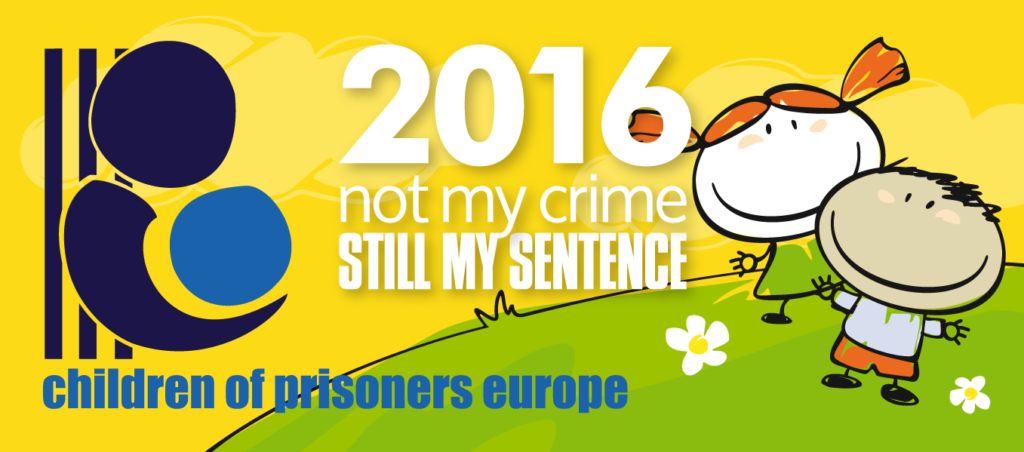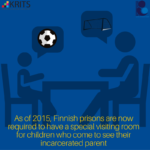This week, Children of Prisoners Europe has focused its “Not my crime, still my sentence” campaign on Article 2 of the Italian Memorandum of Understanding on children with imprisoned parents.
Article 2 of the Memorandum focuses on making prison visits child-friendly. It calls for the designation of a “children’s space” with toys and drawing boards in each waiting room. Supplies such as bottle warmers and changing tables should be made available in these spaces and staff should make the children feel welcome while waiting to see their imprisoned parent. Staff should thus be trained in understanding how children experience a prison visit. For instance, a prison staff member can appear large and frightening from a child’s perspective. Simple actions such as crouching down to a child’s level when speaking to him or her can make staff appear less intimidating and make the child more comfortable. Other simple changes that can make the visit more enjoyable include:
- Allowing physical contact between children and their parents
- Allowing children to take their homework into the visiting room
- Allowing children to bring a gift for their imprisoned parent
- Allowing children and parents to get up off their chairs and move around
- Allowing children to take their favourite book into the visiting room for their parent to read to them.
As well as the waiting rooms, visits rooms should also be equipped with “children’s spaces” so that children can play with their imprisoned parent during their visit. In fact, there should be a complete playroom for children’s visits if the space allows it.
In addition, the second article of the Memorandum asks that age-appropriate information be given to children about the rules and procedures of a prison visit. For instance, security checks that involve sniffer dogs should be explained to children in a non-frightening, friendly manner. Visiting a parent in prison should not have to be a dreaded experience.
The idea behind these and all other clauses under Article 2 is to make children feel comfortable visiting their imprisoned parent and for them to be able to make sense of the experience. Several of COPE’s partners have been successful in accommodating child-friendly visits in their prisons. COPE’s social media this week featured the work of three organizations that have made some particularly interesting progress: Bambinisenzasbarre in Italy, KRITS Probation Foundation in Finland and Relais Enfants-Parents in Belgium.
Bambinisenzasbarre has created “Yellow Spaces” in every Italian prison to serve as socio-educational welcome areas for children. These “Yellow Spaces” are a place for children to play, voice any needs or challenges they have before and after their visit and make sense of the overall experience. Educators from Bambinisenzasbarre accompany the children while they are in the “Yellow Spaces” and support them in any way that they need.
KRITS Probation Foundation pushed for changing some of Finland’s laws concerning imprisonment. The new laws, which were put in place in 2015, require all Finnish prisons to have special visiting rooms for children who come to see their parent. Children are now allowed to touch their parents, hug them and sit on their laps during their visits. Allowing this type of physical contact is very important in fostering the child-parent bond throughout the imprisonment of the parent. Another important change is that imprisoned parents can apply for “family visits” which can be up to a few days in length. These visits would occur in rooms that resemble a living room, with a table, a couch and toys for children and their parents to play with. KRITS continues to work on making these family visits equally accessible to all prisoners since each Finnish prison currently holds its own policy on when and why family visits are allowed.
Lastly, Relais Enfants-Parents Belgique has implemented a unique set-up for children visiting their parent in Belgian prisons. Their trilieux visits system consists of three contrasting recreational environments in which children can interact with their imprisoned parent with the help and support of Relais Enfants-Parents staff when needed. The three different spaces are divided as follows:
- The motor space: a play area where children are able to be physically active. Climbing, running, jumping and asking their parent to watch as they do tricks and show off their strength.
- The calm space: an area where children and their parents can sit or lie down as if they were at home. Reading and playing with puppets are some of the activities available in this space.
- The creative space: an area where children can paint, draw, play and instrument or do arts and crafts with their parent.
Relais Enfants-Parents knows that every child is different and thus has different needs and wants during a prison visit. The trilieux gives children three different spaces for them to choose from according to their needs during the visit. If they feel more comfortable sitting calmly with their parent and a book, there is a space for them to do so. If they would rather run around and play tag with their parent there is also a space for them to comfortably do that. This model acknowledges and is respectful of the differences in children’s recreational needs.










